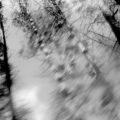
Somewhere between ambient drones and drifting beat programming is the world of Wind and Water, the new release by Loess on n5MD. The duo of Clay Emerson and Ian Pullman sought to create a record that paralleled the natural progression of creation and dissolution, and the ebb and flow of the twelve tracks of Wind and Water captures a gentle progression—both airy and fluid—that is captivatingly natural.
Seemingly a blend of Biosphere’s gentle electronics and Chris Watson’s environmental recordings, “Creshiem” finds waves of wind transforming into delicate melodies and ticking percussive motifs; while “Greenland” hums with the echo of bells across frozen tundra and the noisy chatter of digital crickets. Emerson and Pullman fill their organic landscapes with the micro-detritus of IDM arrhythmia, a laconic programming that seems like nothing more than the redistribution of dust and pollen beneath swirling breezes and winds. Squirts of bird noises are caught in the wake of a organ-like melody in “Lomond,” a gasping, swaying song filled with the huff and puff of air through air bladders and hoses.
A small group of organs stagger about in a field in “Sonde,” trying to keep in some semblance of time with the brisk percussion. One or two keep their tone poems alive while others shudder, swallowing their notes with reflexive decay. Melodies appear to be afraid of being heard, dissolving into inverted echoes of themselves before they are fully realized. “Talus” is a more forceful “Sonde,” like woodblocks and a church organ lost in a windstorm, but the decaying quality of the melodies are still there. A flute, carved from wood by the wind
and blown with those same lips, lends a Japanese flavor to “Veld,” a Shinto meditation on the movement of tree limbs, while the deep and sonorous rumble of mountain streams provides a grumbling undercurrent to the ambiance.
I was surprised at how much of Wind and Water is purely non-environmental. While their source material and artistic inspiration may be natural, the resulting programming is certainly unnatural in its cadence and percussion. That isn’t to say that Wind and Water doesn’t succeed in evoking a sense of natural rhythms—it certainly does—but rather the efforts of Emerson and Pullman are that of restrained pastoralists. The sense of innocence here is not completely akin to Boards of Canada’s winsome characterization of childhood, but Emerson and Pullman are more Thoreau-ean lovers of nature than Blake-ean advocates of innocence realized through experience.
The more I listen to Wind and Water, the more I think its sounds are akin to time-lapse photography. These recreations of the natural landscapes are time-compressed, days and years squeezed into seconds and minutes. These are the sounds the world would make if it were living and dying as fast as we were. In an sense then, Wind and Water isn’t about motion—though it is rife with it—but rather, it is an admonition for non-movement. As “Dasein” fades out, crackling into nothingness, and “III6” glides into my head with its elongated tones (all the rhythms of the preceding fifty minutes have been left behind), I think, “Maybe, I’ll just sit here awhile, still as a flower, and feel the breeze on my face.”
Wind and Water is out now on n5MD.
















![Squaric :: 808 [Remixes] (Diffuse Reality) — [concise]](https://igloomag.com/wp/wp-content/uploads/2025/04/squaric-808-remixes_feat-75x75.jpg)







